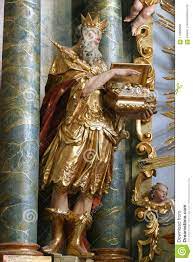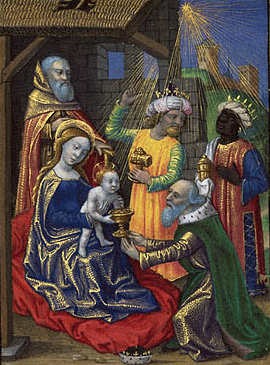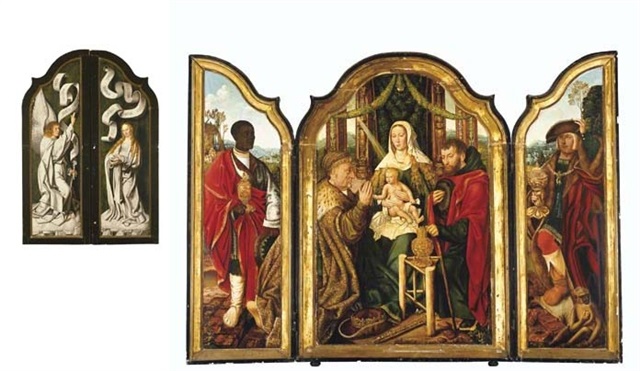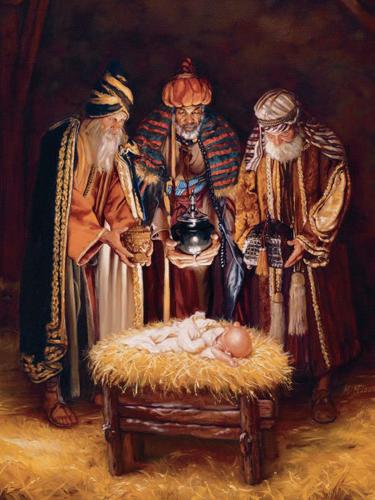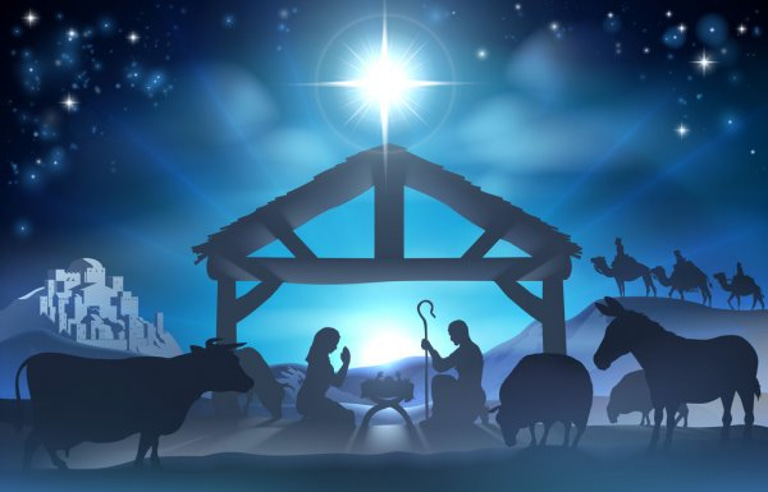Did the Wise Men Choose the Right Gifts for Jesus?
Explore the meaning behind the gifts of gold, frankincense, and myrrh given to Jesus. Understand their significance in His mission as the Savior.
Grace Callahan
12/20/202414 min read
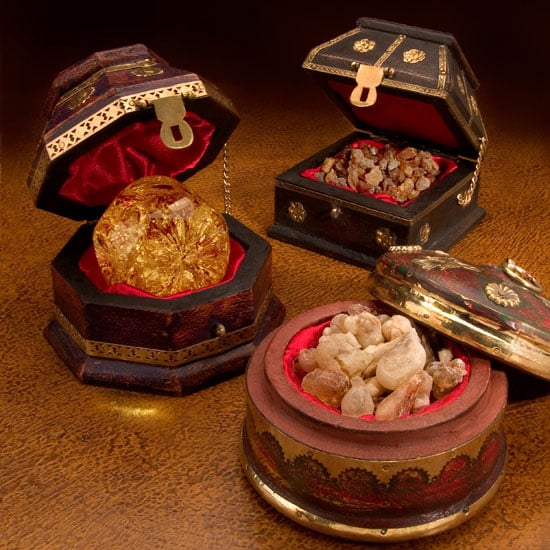

The birth of Jesus Christ, the son of God and the savior of the world, was celebrated by three wise men who came from the east to worship him. They brought with them three gifts: gold, frankincense, and myrrh. These gifts were not only valuable and precious, but also symbolic and prophetic of Jesus' identity and mission. The wise men, also known as magi or astrologers, were Gentiles who recognized the star that announced the birth of the Messiah. They followed the star to Bethlehem, where they found the child with his mother Mary. They bowed down and worshiped him, and presented their gifts to him. According to tradition, the names of the three wise men were Melchior, Balthazar, and Caspar. Melchior gave gold, Balthazar gave frankincense, and Caspar gave myrrh.
Gold
Melchior Gave Gold
Who was Melchior?
Tradition describes Melchior as an elderly man with a long white beard, representing Europe. His gift, gold, symbolizes Jesus' kingship and divine authority.
Why Gold?
Gold was the most precious metal of the ancient world, universally associated with royalty, wealth, and power. By presenting gold, Melchior honored Jesus as the "King of the Jews" (Matthew 2:2), a title the Magi may have known through the prophecy of a ruler arising in Israel (Micah 5:2). Gold also signified divinity in many cultures, pointing to Jesus as the King of kings and Lord of lords (Revelation 19:16).
Melchior’s offering acknowledged Jesus' sovereignty, not just as the King of Israel but as the eternal ruler of all nations. This aligns with prophecies such as Isaiah 60:3, which foretells:
“Nations will come to your light, and kings to the brightness of your dawn.”
Gold as a Symbol of Royalty
In ancient times, gold was often reserved for kings and rulers. It adorned palaces, thrones, and crowns, signifying ultimate authority and dominion. When the Magi brought gold to Jesus, they were declaring His kingship. They likely understood Him to be the fulfillment of the prophecy found in Micah 5:2:
“But you, Bethlehem Ephrathah, though you are small among the clans of Judah, out of you will come for me one who will be ruler over Israel, whose origins are from of old, from ancient times.”
Although born in a humble stable, Jesus was no ordinary child. He was the promised ruler and heir to David’s throne, as the angel had declared to Mary:
“The Lord God will give him the throne of his father David, and he will reign over Jacob’s descendants forever; his kingdom will never end.” (Luke 1:32-33)
The gift of gold was a tangible way of honoring Jesus as the true King of Israel, as well as the King of all nations.
Gold as a Symbol of Divinity
Gold’s incorruptibility and unchanging nature make it a fitting symbol for the divine. Unlike other materials, gold does not tarnish, decay, or corrode, making it a symbol of purity and eternity. This reflects the sinless nature of Jesus, who is God incarnate (John 1:1,14). The Magi’s offering of gold acknowledges Jesus not only as a king but also as divine—God in human form, come to dwell among His people.
The gift also connects to the holiness of the temple in Jerusalem, where gold was used extensively to signify God’s presence and glory. For example, the Ark of the Covenant was overlaid with pure gold (Exodus 25:10-11), and the inner sanctuary of Solomon’s Temple was covered in gold (1 Kings 6:20-22). These sacred uses of gold pointed to the presence of God, and now, the Magi’s gold points to Jesus, the ultimate manifestation of God’s presence on earth.
Gold as a Prophetic Fulfillment
The gift of gold also fulfills Old Testament prophecies about the Messiah and the nations coming to worship Him. Isaiah foresaw this moment centuries earlier:
“Nations will come to your light, and kings to the brightness of your dawn. … And all from Sheba will come, bearing gold and incense and proclaiming the praise of the Lord.” (Isaiah 60:3,6)
This prophecy speaks of a time when the nations would recognize and honor the Messiah. The Magi, coming from the East (likely Persia, Babylon, or Arabia), represent the fulfillment of this vision. Their journey demonstrates that Jesus’ kingship is not limited to Israel but extends to all people, fulfilling God’s promise to Abraham that through his descendants, “all nations on earth will be blessed” (Genesis 22:18).
Gold and Jesus’ Future Glory
Gold also foreshadows the future glory and majesty of Jesus. While He was born in a manger and lived a humble life, His ultimate purpose was to reign as the exalted King. The book of Revelation gives us a glimpse of this future reign:
“The city does not need the sun or the moon to shine on it, for the glory of God gives it light, and the Lamb is its lamp. The nations will walk by its light, and the kings of the earth will bring their splendor into it.” (Revelation 21:23-24)
The gold brought by the Magi serves as a reminder that Jesus will one day be recognized by all as the rightful King. Every knee will bow, and every tongue will confess that Jesus Christ is Lord (Philippians 2:10-11).
Gold as an Act of Worship
The Magi’s offering of gold was not just a practical gift or a token of respect—it was an act of worship. Matthew 2:11 tells us that they “bowed down and worshiped him” before presenting their gifts. Their journey, likely spanning hundreds of miles, demonstrates their reverence and devotion. By giving gold, they acknowledged Jesus’ worthiness to receive the highest honor, echoing the psalmist’s declaration:
“May the kings of Tarshish and of distant shores bring tribute to him. May the kings of Sheba and Seba present him gifts. May all kings bow down to him and all nations serve him.” (Psalm 72:10-11)
Application for Today
The gold given to Jesus reminds us of who He is—our eternal King, holy and incorruptible. It challenges us to honor Him in our own lives. While we may not have gold to lay at His feet, we can give Him our worship, our obedience, and our hearts, offering the best of what we have as a reflection of His worth.
The story of the Magi’s gold continues to inspire believers to approach Jesus with awe and reverence, acknowledging Him not only as the King of kings but as Emmanuel—God with us (Matthew 1:23).
Frankincense
Balthazar Gave Frankincense
Who was Balthazar?
Tradition depicts Balthazar as a middle-aged man of darker complexion, often from Arabia or Africa. He presented frankincense, an aromatic resin used in religious rituals.
Why Frankincense?
Frankincense was used as incense in temple worship, symbolizing prayers rising to God (Psalm 141:2). Its use in religious ceremonies reflects the divine nature of Jesus, acknowledging Him as God incarnate. By offering frankincense, Balthazar recognized Jesus’ role as the great High Priest, who would mediate between humanity and God.
This gift also signifies worship, as the Magi bowed before Jesus and adored Him (Matthew 2:11). The offering of frankincense fulfilled prophecies like Isaiah 60:6, which foretold nations bringing incense to honor the Messiah:
“And all from Sheba will come, bearing gold and incense and proclaiming the praise of the Lord.”
Balthazar’s gift acknowledges Jesus as worthy of worship and highlights His divine nature.
Frankincense as a Symbol of Jesus’ Priesthood
The gift of frankincense acknowledges Jesus as the ultimate High Priest of the new covenant. In the Old Testament, priests would burn incense as part of their worship and intercession in the temple. Exodus 30:34-36 describes how God commanded the Israelites to make a holy incense to be burned before Him, representing prayers and offerings made on behalf of the people:
“Let my prayer be set before You as incense, the lifting up of my hands as the evening sacrifice.” (Psalm 141:2)
As our High Priest, Jesus fulfills and surpasses the priestly role of the Old Testament. He is the one who mediates between God and humanity, offering Himself as the perfect sacrifice for sin. The book of Hebrews describes His priestly work:
“For Christ did not enter a sanctuary made with human hands … He entered heaven itself, now to appear for us in God’s presence.” (Hebrews 9:24)
Frankincense, with its association to temple worship and priestly intercession, points to Jesus’ role as the mediator of a better covenant (Hebrews 8:6).
Frankincense as a Symbol of Jesus’ Humanity
While frankincense is often tied to divinity and worship, it also symbolizes the humanity of Jesus. Incense is made from natural resin, derived from the earth, which reflects the incarnation of Christ—God taking on human flesh. John 1:14 beautifully declares this mystery:
“The Word became flesh and made his dwelling among us. We have seen his glory, the glory of the one and only Son, who came from the Father, full of grace and truth.”
The fragrance of frankincense, sweet and pleasing, parallels the beauty and perfection of Jesus’ earthly life. His words, actions, and ministry were a “pleasing aroma” to God (Ephesians 5:2), demonstrating perfect obedience and love in everything He did.
Frankincense as a Foreshadowing of Sacrifice
Frankincense also foreshadows Jesus’ sacrificial death and His role as our intercessor. In temple worship, incense was often burned alongside sacrifices, symbolizing the prayers and devotion of the people rising to God. Similarly, Jesus’ life and death were an offering to God, fragrant and pleasing:
“Christ loved us and gave himself up for us as a fragrant offering and sacrifice to God.” (Ephesians 5:2)
This gift hints at Jesus’ destiny to lay down His life for the salvation of the world. His sacrifice was not a mere ritual but a once-for-all atonement for sin, fulfilling the Old Testament sacrificial system (Hebrews 10:10-12). The ascending smoke of frankincense reflects Jesus’ role in interceding for us even now, seated at the right hand of God (Romans 8:34):
“Therefore, he is able to save completely those who come to God through him, because he always lives to intercede for them.” (Hebrews 7:25)
Fulfillment of Prophecy
The Magi’s offering of frankincense also fulfills the Messianic prophecies of the Old Testament. Psalm 72 foretells the nations bringing gifts to honor the Messiah:
“May the kings of Tarshish and of distant shores bring tribute to him. May the kings of Sheba and Seba present him gifts.” (Psalm 72:10)
The inclusion of frankincense specifically aligns with Isaiah’s prophecy of nations coming to worship the light of Israel’s Messiah:
“Nations will come to your light, and kings to the brightness of your dawn. … And all from Sheba will come, bearing gold and incense and proclaiming the praise of the Lord.” (Isaiah 60:3,6)
The Magi’s act of worship through their gifts underscores that Jesus is not only the King of Israel but the Savior of the whole world.
Frankincense as an Act of Worship
Frankincense, offered by Balthazar in tradition, reflects the Magi’s recognition of Jesus’ dual nature—both fully God and fully man. Their act of giving was not a mere formality but an expression of profound reverence and worship. Matthew 2:11 records their response upon seeing Jesus:
“On coming to the house, they saw the child with his mother Mary, and they bowed down and worshiped him. Then they opened their treasures and presented him with gifts of gold, frankincense, and myrrh.”
The rising fragrance of frankincense symbolizes prayers and worship lifted to God. By giving this gift, the Magi acknowledged Jesus as worthy of worship and recognized Him as the divine High Priest who bridges the gap between humanity and God.
Application for Today
The gift of frankincense invites us to reflect on our own worship and devotion. Just as incense rises to God, our prayers and lives should be offered as a pleasing aroma to Him. It reminds us that Jesus is our perfect High Priest, who intercedes on our behalf and who offered Himself for our salvation. In response, we are called to approach Him with gratitude, reverence, and worship, recognizing Him as the true God who became man for our sake.
Myrrh
Caspar Gave Myrrh
Who was Caspar?
Tradition describes Caspar as a younger man from the region of India. His gift, myrrh, was a resin used in perfumes, anointing oils, and burial preparations.
Why Myrrh?
Myrrh is the most somber of the three gifts, symbolizing Jesus’ humanity and the suffering He would endure as the Savior of the world. It foreshadows His sacrificial death, as myrrh was commonly used to embalm bodies (John 19:39-40).
Caspar’s gift reflects his recognition of Jesus as the Suffering Servant prophesied by Isaiah:
“He was pierced for our transgressions, he was crushed for our iniquities; the punishment that brought us peace was on him, and by his wounds we are healed.” (Isaiah 53:5)
Additionally, myrrh points to Jesus’ role as a healer, as it was used medicinally in the ancient world. His death would not only atone for sin but bring spiritual healing and eternal life to all who believe in Him.
By giving myrrh, Caspar honored Jesus as the Savior and trusted Him as the one who would suffer, die, and rise again to bring salvation.
Myrrh is a resin derived from the sap of small thorny trees, particularly of the Commiphora species, native to regions like Arabia, Ethiopia, and Somalia. In ancient times, myrrh was an expensive and treasured commodity used in perfumes, anointing oils, and medicines. It also played a central role in burial customs due to its aromatic and preservative qualities. The Magi’s gift of myrrh to Jesus was deeply symbolic, foreshadowing key aspects of His mission as the Prophet, Suffering Servant, and Savior of the world.
Myrrh as a Symbol of Prophecy
As a Prophet, Jesus came to proclaim the truth of God, call people to repentance, and reveal God’s will for humanity. Prophets often faced rejection and suffering as they confronted sin and pointed to God’s redemptive plan. Myrrh, with its dual uses for anointing and embalming, serves as a profound symbol of both the authority and the suffering inherent in Jesus’ prophetic ministry.
The gift of myrrh aligns with Jesus’ own acknowledgment of His role as a prophet:
“A prophet is not without honor except in his own town, among his relatives and in his own home.” (Mark 6:4)
Caspar’s offering of myrrh recognized Jesus not only as a Prophet but as the Prophet, the one foretold by Moses:
“The Lord your God will raise up for you a prophet like me from among you, from your fellow Israelites. You must listen to him.” (Deuteronomy 18:15)
Myrrh as a Symbol of Suffering and Death
Myrrh’s bitter taste and connection to burial practices foreshadow the suffering and death Jesus would endure for the salvation of humanity. Isaiah’s prophecy vividly portrays the anguish of the Messiah:
“He was despised and rejected by mankind, a man of suffering, and familiar with pain.” (Isaiah 53:3)
The bitterness of myrrh parallels the bitter cup of suffering that Jesus willingly drank for our redemption. In fact, myrrh was offered to Him on the cross mixed with wine as a mild anesthetic, but He refused it, choosing to endure the full measure of suffering:
“They offered him wine mixed with myrrh, but he did not take it.” (Mark 15:23)
This gift pointed directly to the ultimate purpose of Jesus’ earthly ministry: to lay down His life as the sacrificial Lamb of God who takes away the sins of the world (John 1:29).
Myrrh as a Symbol of Burial and Sacrifice
Myrrh’s use in embalming and burial customs ties it to Jesus’ death and burial. After Jesus died on the cross, Nicodemus and Joseph of Arimathea prepared His body with a mixture of myrrh and aloes, as was customary:
“Nicodemus brought a mixture of myrrh and aloes, about seventy-five pounds. Taking Jesus’ body, the two of them wrapped it, with the spices, in strips of linen.” (John 19:39-40)
The myrrh in this burial ritual fulfilled the gift’s symbolic meaning, foreshadowing the death that Jesus came into the world to accomplish. It also underscores the costly nature of His sacrifice, as myrrh was an expensive substance, reflecting the immeasurable value of Jesus’ atonement.
Myrrh as a Symbol of Healing and Resurrection
While myrrh’s connection to suffering and death is central, it also carries a hopeful note as a symbol of healing and restoration. In ancient medicine, myrrh was used as a healing balm for wounds and as an antiseptic. This healing property points to the redemptive and life-giving work of Jesus, whose death brings spiritual healing to humanity:
“But he was pierced for our transgressions, he was crushed for our iniquities; the punishment that brought us peace was on him, and by his wounds we are healed.” (Isaiah 53:5)
The story of myrrh does not end with death—it also looks forward to resurrection. Jesus’ suffering and burial were not the end of His story, but the beginning of a new hope for all who believe in Him. By rising from the dead, He overcame the bitterness of death and offers eternal life and healing to His followers.
Myrrh as a Symbol of Worship and Trust
By giving myrrh, Caspar expressed deep reverence for Jesus and recognized Him as the Savior. This gift, alongside gold and frankincense, encapsulates the Magi’s understanding of Jesus’ multifaceted identity: King, Priest, and Prophet. Myrrh specifically highlights His humanity, suffering, and sacrificial love. It reflects the Magi’s trust in Jesus as the one who would fulfill God’s redemptive plan and bring salvation to the world.
Fulfillment of Prophecy
The gift of myrrh also connects to broader Messianic prophecies about the nations worshiping the Messiah. Psalm 72, a royal psalm pointing to the future reign of the King-Messiah, declares:
“May the kings of Sheba and Seba present him gifts. … May all nations be blessed through him and call him blessed.” (Psalm 72:10,17)
The inclusion of myrrh among the Magi’s gifts underscores their recognition of Jesus as the fulfillment of these prophecies.
Application for Today
The gift of myrrh challenges us to reflect on the depth of Jesus’ sacrifice and the healing it brings. It calls us to respond with gratitude, humility, and trust in His saving work. Just as myrrh was both bitter and fragrant, the story of Jesus’ life, death, and resurrection reminds us that through suffering comes redemption, and through His death comes eternal life.
In our own lives, we are invited to anoint Jesus with the “myrrh” of our devotion and trust, offering Him not only our worship but also our willingness to embrace His call to carry our own crosses and follow Him (Matthew 16:24-25).
The Symbolism of the Three Gifts Together
The gifts of the Magi—gold, frankincense, and myrrh—carry profound spiritual and prophetic significance, illustrating the depth of Jesus' identity and His mission to redeem the world. Each gift individually symbolizes a crucial aspect of who He is and what He came to accomplish:
Gold:
Symbolizes kingship and divine authority.
It represents Jesus as the King of kings, fulfilling the prophecy that a ruler would come from Bethlehem to shepherd God's people (Micah 5:2).
Gold reflects the wealth and splendor fitting for a king and acknowledges Jesus' rightful place on the eternal throne of David (Luke 1:32-33).
Frankincense:
Honoring His priestly role and divinity, frankincense symbolizes worship.
It represents Jesus as the High Priest who mediates between humanity and God, offering Himself as the ultimate sacrifice for sin (Hebrews 7:26-27).
Its use in temple rituals points to Jesus as Immanuel, "God with us" (Matthew 1:23), worthy of our praise and adoration.
Myrrh:
Foreshadows His suffering, death, and ultimate resurrection.
Myrrh’s association with burial and embalming prefigures Jesus’ crucifixion and His role as the Lamb of God who takes away the sins of the world (John 1:29).
It also speaks to the healing and eternal life that Jesus brings, fulfilling Isaiah’s prophecy: “By His wounds we are healed” (Isaiah 53:5).
The Unified Message of the Gifts
When viewed together, the gifts form a unified proclamation of Jesus’ threefold office as King, God, and Savior:
Gold reveals His sovereign rule.
Frankincense points to His divine nature and intercessory priesthood.
Myrrh underscores His sacrificial death and redemptive mission.
This triad of gifts reflects the Magi's extraordinary understanding of who Jesus is. Their worship and offerings fulfilled prophecies like Psalm 72:10-11:
“May the kings of Tarshish and of distant shores bring tribute to him. May the kings of Sheba and Seba present him gifts. May all kings bow down to him and all nations serve him.”
Theological and Prophetic Fulfillment
The gifts not only honored Jesus but also affirmed the fulfillment of Old Testament prophecies that Gentile nations would come to worship the Messiah, bearing treasures and proclaiming His glory (Isaiah 60:3,6). These gifts emphasized that Jesus’ mission extended beyond Israel to the whole world, drawing all nations to His light.
An Invitation for Us
The Magi’s gifts remind us to approach Jesus with reverence, offering our own lives in worship. Each gift invites us to reflect on Jesus’ multifaceted identity:
Gold calls us to honor Him as our King and submit to His reign.
Frankincense encourages us to worship Him as our God and trust in His priestly intercession.
Myrrh challenges us to embrace the depth of His sacrifice and the hope of resurrection.
Just as the Magi traveled far to offer their treasures, we are invited to bring the treasure of our hearts, lives, and devotion to Jesus, the King, God, and Savior of all.
